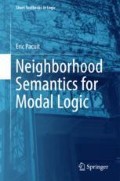Abstract
This chapter surveys different extensions of the basic modal language interpreted on neighborhood structures. The chapter begins with a fascinating characterization of augmented neighborhood models in modal languages with the universal modality and nominals. There is an overview of the interesting issues that arise when multi-agent modal languages with common belief operators are interpreted on neighborhood models. There is an extended discussion of game logic, a non-normal modal logic containing modalities labeled with game expressions that are intended to describe two-player games and what the players can achieved in these games. The chapter also includes a discussion of first-order extensions (including a brief discussion of first-order topological models). Finally, there is a discussion of modalities describing changes to neighborhood models, familiar from the literature on dynamic epistemic logic.
Access this chapter
Tax calculation will be finalised at checkout
Purchases are for personal use only
Notes
- 1.
See Goranko and Passy (1992) for a discussion of the universal modality and Areces and ten Cate (2007) for a discussion of nominals in modal logic.
- 2.
It should also be verified that Lindenbaum’s Lemma holds for \(\mathbf {EMA}\). I leave the verification of this to the reader.
- 3.
The Axiom of Choice says that for any collection of non-empty sets indexed by any set I, \((X_i)_{i\in I}\), there is a sequence \((x_i)_{i\in I}\) of elements such that for all \(i\in I\), \(x_i\in X_i\).
- 4.
The usual restrictions apply when substituting y for x in \(\varphi \) so that either bound variables are renamed or y is assumed to be substitutable for x in \(\varphi \). See Enderton (2001) for a discussion.
- 5.
This is part of the standard toolkit for proving completeness of first-order logic. Consult Enderton (2001) for details. See, also, Hughes and Cresswell (1996), p. 258, for a discussion in the context of first-order modal logic.
- 6.
The textbooks Fagin et al. (1995) and van Benthem (2011) also provide illuminating discussions of key logical issues.
- 7.
There are rich literatures in logic (Halpern and Moses 1990; Heifetz 1999; van Benthem and Sarenac 2004; Barwise 1987), philosophy (Cubitt and Sugden 2003; Lewis 1969), and game theory (Geanakoplos 1995; Monderer and Samet 1989; Pacuit and Roy 2015) focused on common belief. It is beyond the scope of this book to discuss this literature.
- 8.
Technically, the emptyset \(\emptyset \) is evident since \(\emptyset =m_G(\emptyset )\); however, \(w\not \in m_G(\emptyset )\). Notice that if \(\emptyset \) is in everyone’s neighborhood, then, according to the definition of \(C_G^2\), every event will be common believed.
- 9.
See Definition A.16 for the difference between strong and weak completeness. It is well known that, in general, logics with common belief operators are not compact, and so cannot be strongly complete.
- 10.
For this section, it is useful to have some basic understanding of game theory (Leyton-Brown and Shoham 2008). In Sect. 1.4.5, I introduced strategic games (Definition 1.39). In this section, I will also discuss extensive games. These are games in which the players do not necessarily make their choices simultaneously. I will restrict attention to two-player games in which the players take turns making moves. These are represented by trees in which the edges are labeled by actions, and each non-terminal node is associated with a player whose turn it is to move. The terminal nodes assign a payoff to each of the players.
- 11.
A strategy for Eloise (in an extensive game) is a function that assigns an action at each of her choice nodes.
- 12.
Recall the example used when discussing the logic of ability in Sect. 1.3.
- 13.
Cf. Bonanno (1992) for a related discussion.
- 14.
See Harel et al. (2000) for a discussion of propositional dynamic logic and its applications for reasoning about programs. See also Peleg (1987), Goldblatt (1992b), van Benthem et al. (2008) and Pacuit and Simon (2011) for variations of propositional dynamic logic related to topics discussed in this section.
- 15.
Consult Pacuit (2013b) for a shorter survey of this research area.
- 16.
The belief revision literature (Alchourrón et al. 1985) contains a number of different ways to change an agent’s beliefs given an observation that is inconsistent with the agent’s current beliefs (cf. van Benthem 2011).
- 17.
Removing the evidence for \(\varphi \) is weaker than the usual notion of contracting one’s beliefs by \(\varphi \) in the theory of belief revision (Rott 2001). It is possible to remove the evidence for \(\varphi \) and yet the agent maintains her belief in \(\varphi \). Formally, \([-\varphi ]\lnot B \varphi \) is not valid. To see this, let \(W=\{w_1,w_2,w_3\}\) with p true only at \(w_3\). Consider an evidence model with two pieces of evidence: \(\mathcal {E}=\{\{w_1,w_3\}, \{w_2,w_3\}\}\). The agent believes p and, since the model does not change when removing the evidence for p, \([-p]Bp\) is true. The same is true for the model with explicit evidence for p—i.e., \(\mathcal {E}'=\{\{w_1,w_3\}, \{w_2,w_3\}, \{w_3\}\}\).
- 18.
The precondition is needed because the set of all worlds W is an evidence set.
Author information
Authors and Affiliations
Corresponding author
Rights and permissions
Copyright information
© 2017 Springer International Publishing AG
About this chapter
Cite this chapter
Pacuit, E. (2017). Richer Languages. In: Neighborhood Semantics for Modal Logic. Short Textbooks in Logic. Springer, Cham. https://doi.org/10.1007/978-3-319-67149-9_3
Download citation
DOI: https://doi.org/10.1007/978-3-319-67149-9_3
Published:
Publisher Name: Springer, Cham
Print ISBN: 978-3-319-67148-2
Online ISBN: 978-3-319-67149-9
eBook Packages: Religion and PhilosophyPhilosophy and Religion (R0)

